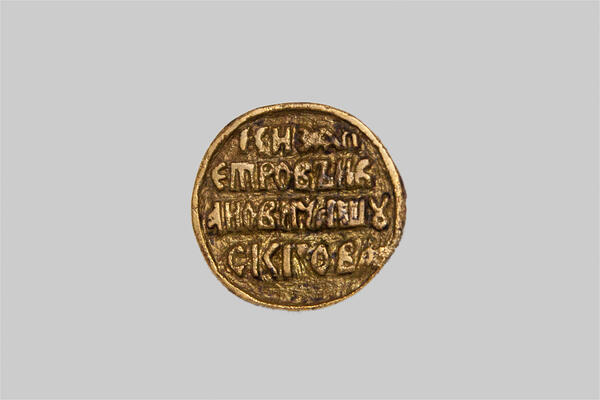For the first time, the sign from the chain mail was presented in the catalogue of finds from the Isker settlement. Vasily Pignatti, the compiler of the catalogue, drew attention to the inscription “Held by Lord Pyotr Ivanovich Shuysky” and asked a question: “Do the words above mean that the kinsman or things (weapons) belong to the druzhina of Lord Pyotr Ivanovich Shuysky, who died in 1564 and led the Russian squads in the fight against the Kazan Tatars?”.
Lord Pyotr Ivanovich Shuysky was a prominent military official and statesman of Moscow Russia in the 1540s and the first half of the 1560s. His last position was the Viceroy of Polotsk in 1563. In the battle of Chashniki near Orsha on January 26, 1564, Russian troops under the command of Pyotr Shuysky were defeated by the Lithuanian army of Hetman Nikolay Radzivill Ryzhy. When retreating from the battlefield, the Russian commander-in-chief was killed.
A similar target sign is kept in the Armoury Chamber, it was delivered there in the 17th century from Western Siberia. In the second quarter of the 17th century service men from Berezovsk “recaptured” the chain mail from the Priobsky Samoyeds (Nenets), and “there were gold target signs on that shell on the chest, and the sovereign”s name was carved on one of them, and an eagle on the other”. On closer examination, it was found that the target plates were not gold, but copper: “a double-headed eagle is carved on one of them, and the signature of Lord Pyotr Ivanovich Shuysky on the other”. When the chain mail was delivered to Moscow, it was found that only one copper plate with gilt remained on it, which could be used to determine that the item belonged to Shuysky.
Finding a similar sign on Isker, perhaps from the same shell, allowed the famous historian Sergey Bakhrushin to express the assumption with some reservations that the chain mail of Pyotr Shuysky once belonged to ataman Yermak, and he lost a plate from it during his stay in the Siberian capital. It is known that in the 1980s of the 16th century, after the victory over the troops of Khan Kuchum in the battle of the Chuvash Cape, Yermak’s squad occupied the settlement of Isker without a fight, where they lived for several years later. According to an employee of the Moscow Kremlin Armoury Nikolay Gordeev, ‘the Tobolsk target must have once been on Yermak”s second shell’, he received it as a gift from Tsar Ivan IV the Terrible as a reward for the Siberian expedition.
Lord Pyotr Ivanovich Shuysky was a prominent military official and statesman of Moscow Russia in the 1540s and the first half of the 1560s. His last position was the Viceroy of Polotsk in 1563. In the battle of Chashniki near Orsha on January 26, 1564, Russian troops under the command of Pyotr Shuysky were defeated by the Lithuanian army of Hetman Nikolay Radzivill Ryzhy. When retreating from the battlefield, the Russian commander-in-chief was killed.
A similar target sign is kept in the Armoury Chamber, it was delivered there in the 17th century from Western Siberia. In the second quarter of the 17th century service men from Berezovsk “recaptured” the chain mail from the Priobsky Samoyeds (Nenets), and “there were gold target signs on that shell on the chest, and the sovereign”s name was carved on one of them, and an eagle on the other”. On closer examination, it was found that the target plates were not gold, but copper: “a double-headed eagle is carved on one of them, and the signature of Lord Pyotr Ivanovich Shuysky on the other”. When the chain mail was delivered to Moscow, it was found that only one copper plate with gilt remained on it, which could be used to determine that the item belonged to Shuysky.
Finding a similar sign on Isker, perhaps from the same shell, allowed the famous historian Sergey Bakhrushin to express the assumption with some reservations that the chain mail of Pyotr Shuysky once belonged to ataman Yermak, and he lost a plate from it during his stay in the Siberian capital. It is known that in the 1980s of the 16th century, after the victory over the troops of Khan Kuchum in the battle of the Chuvash Cape, Yermak’s squad occupied the settlement of Isker without a fight, where they lived for several years later. According to an employee of the Moscow Kremlin Armoury Nikolay Gordeev, ‘the Tobolsk target must have once been on Yermak”s second shell’, he received it as a gift from Tsar Ivan IV the Terrible as a reward for the Siberian expedition.



